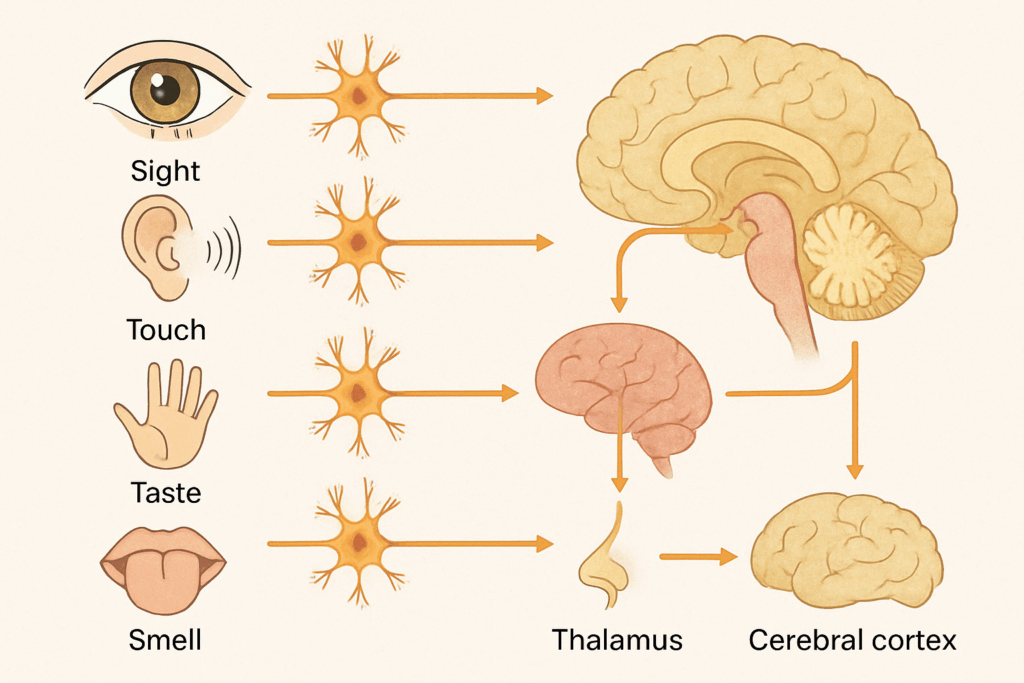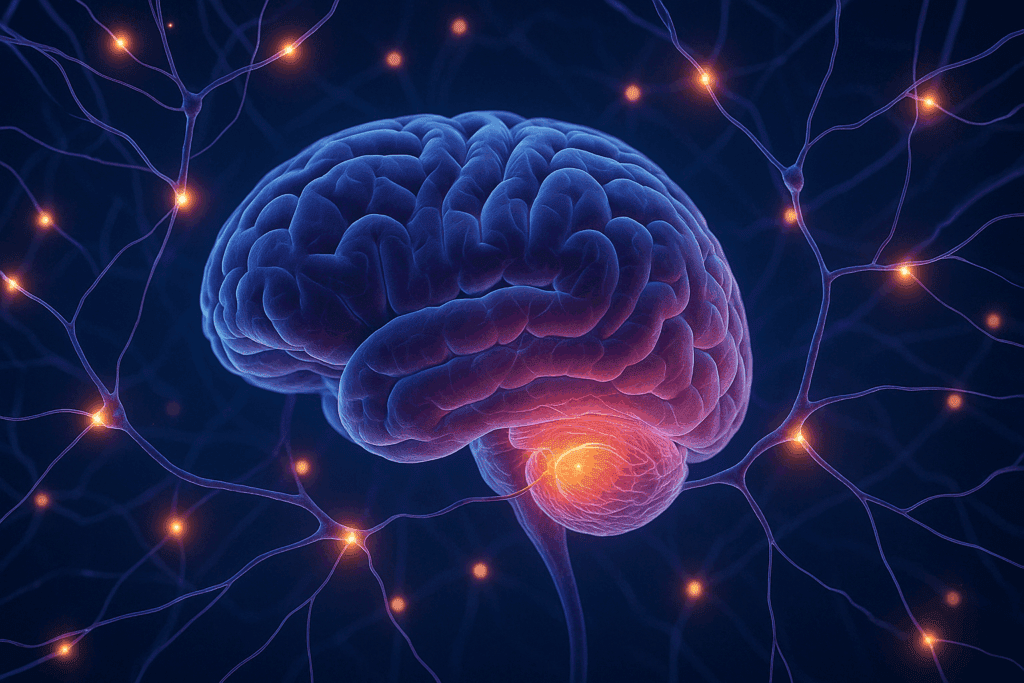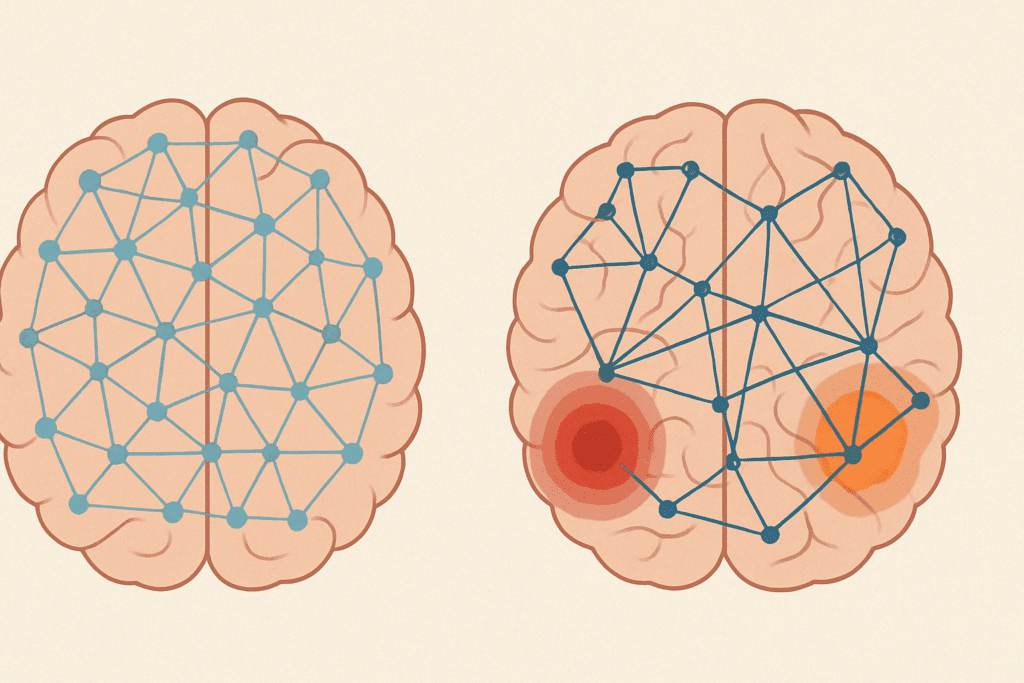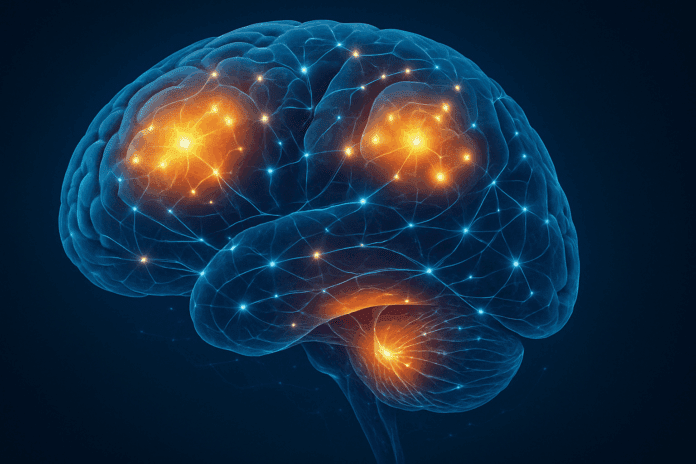How the Brain Processes Information: A Complex Symphony of Cognitive Functions
The process of how your brain interprets and organizes information is often referred to as cognitive processing. It describes the intricate mechanisms the brain employs to make sense of sensory input and internal thoughts. Brain processing is not a standalone function but rather a collaborative effort between neural networks, chemical signals, and various brain regions. For instance, when you read, the visual information is analyzed by the occipital lobe, while your Wernicke’s area facilitates language comprehension. This demonstrates the brain’s remarkable ability to coordinate complex activities in mere fractions of a second, all while seamlessly integrating multiple tasks.
What is it called when your brain processes information? In scientific terms, this process encompasses several cognitive functions, including perception, attention, memory encoding, and executive function. Cognitive neuroscientists refer to this process broadly as “cognitive processing” or “neural information processing.” These terms describe how information travels through neural networks, is categorized, interpreted, and then stored or acted upon. Each type of information—whether it is auditory, visual, tactile, or emotional—is managed by specific neural circuits, which are constantly updated based on experience and learning. As our brain gathers more data, it refines its pathways, making future processing faster and more accurate.
Understanding the depth of brain processing is essential not just for academic interest but for practical implications, especially regarding mental health. When these cognitive systems malfunction or become dysregulated, the consequences can be far-reaching. Conditions such as anxiety, depression, ADHD, and PTSD all have roots in disrupted brain processing mechanisms. For example, in individuals with PTSD, the amygdala becomes hyperactive, leading to heightened responses to perceived threats. This abnormality in processing emotional information can severely impact daily functioning and quality of life. As we unravel the complexity of neural information processing, we can develop more targeted and effective mental health treatments.
In modern neuroscience, advances in neuroimaging and computational modeling have allowed researchers to map brain processing in real-time. Functional MRI (fMRI), for instance, lets us observe which areas of the brain activate during specific cognitive tasks, providing a window into the real-time dynamics of thought. These innovations have not only deepened our understanding of what happens when your brain processes information but also opened new pathways for early diagnosis and intervention in mental health disorders. The more we learn, the clearer it becomes that brain processing underlies every aspect of human experience, and understanding it is crucial to both mental clarity and emotional resilience.
You may also like: Boost Brain Power Naturally: Evidence-Based Cognitive Training Activities and Memory Exercises That Support Long-Term Mental Health

The Architecture of the Brain: How Structure Supports Function
To appreciate the intricacies of brain processing, we must first explore the architecture of the brain. The human brain, weighing approximately three pounds, contains over 86 billion neurons interconnected by trillions of synapses. These neurons communicate through electrochemical signals, forming the foundation of cognitive processing. When we ask, “What is it called when your brain processes information?” we are acknowledging this complex communication system that enables thought, memory, emotion, and behavior. Each region of the brain has specialized roles that contribute to the seamless integration of information.
The cerebral cortex, the outermost layer of the brain, is responsible for higher-order cognitive functions such as reasoning, language, and decision-making. It is divided into four primary lobes: frontal, parietal, temporal, and occipital. The frontal lobe, in particular, plays a pivotal role in executive functions such as planning, judgment, and emotional regulation. Damage or dysfunction in this region can lead to impaired decision-making, difficulty in regulating emotions, and poor impulse control—all hallmarks of several mental health disorders.
Deep within the brain lie structures such as the hippocampus and amygdala, which are integral to memory formation and emotional processing, respectively. The hippocampus encodes and retrieves episodic memories, enabling us to remember past experiences and learn from them. The amygdala, on the other hand, attaches emotional significance to sensory input, influencing how we respond to different situations. In individuals with anxiety disorders, heightened activity in the amygdala can cause exaggerated fear responses even in non-threatening situations, demonstrating how brain processing abnormalities can manifest as psychological symptoms.
Another critical component of brain processing is the thalamus, often referred to as the brain’s relay station. It receives sensory input and directs it to the appropriate cortical areas for further processing. This routing function is vital for attention and awareness. If the thalamus fails to properly filter information, individuals may become overwhelmed by sensory stimuli, a characteristic feature seen in certain neurodevelopmental disorders like autism spectrum disorder. Similarly, the basal ganglia play a key role in motor control and habit formation, showing that brain processing also governs our physical actions.
Understanding the anatomical basis of brain processing not only enriches our appreciation of cognitive function but also highlights potential targets for therapeutic intervention. Advances in neuroscience have revealed that brain plasticity—the brain’s ability to reorganize itself by forming new neural connections—offers promising avenues for recovery and adaptation. Whether through cognitive behavioral therapy, mindfulness practices, or neuromodulation techniques, we can harness this plasticity to improve mental health outcomes. Thus, the structure of the brain is not just a static framework but a dynamic system capable of growth and change, deeply intertwined with how we process information and maintain psychological well-being.

From Sensation to Perception: The Flow of Neural Information
The journey of brain processing begins with sensation—the detection of stimuli through our five senses: sight, hearing, touch, taste, and smell. These raw inputs are then transformed into meaningful perceptions by the brain, a process that involves a sophisticated chain of events. Sensory neurons first transmit signals to the spinal cord and brainstem, which then relay this information to the thalamus. From there, it is sent to specific areas of the cerebral cortex for interpretation. For instance, visual stimuli are processed in the occipital lobe, while auditory signals are interpreted in the temporal lobe. This transition from raw data to conscious awareness exemplifies what is called brain processing.
Perception, however, is not merely a passive receipt of information. It is an active construction influenced by prior experiences, expectations, and context. The brain uses predictive coding to anticipate incoming data, allowing it to process information more efficiently. This is why optical illusions can trick us—our brain fills in gaps based on what it expects to see. In this sense, brain processing is not a mirror of reality but an interpretation that aligns with our internal models of the world. These internal models are constantly updated through feedback loops, making brain processing a dynamic and adaptive system.
Memory also plays a crucial role in perception. When we encounter a familiar stimulus, the brain quickly retrieves stored information to aid in recognition. This process is facilitated by the hippocampus, which links new sensory input with existing memories. Emotional context, provided by the amygdala, further colors our perceptions. For example, a particular scent might evoke a vivid memory and emotional response, demonstrating the integration of multiple brain systems in processing information. The question, “What is it called when your brain processes information?” thus encapsulates a multi-dimensional operation involving memory, emotion, and sensory input.
Dysfunctions in this sensory-perceptual process can lead to a range of mental health issues. In schizophrenia, for instance, individuals may experience hallucinations due to disruptions in the brain’s ability to differentiate between internal thoughts and external stimuli. Similarly, in anxiety disorders, heightened sensitivity to perceived threats can cause the brain to overinterpret benign stimuli as dangerous. These examples highlight the importance of accurate brain processing in maintaining a stable sense of reality. The brain’s capacity to process information correctly is not just a cognitive advantage; it is a cornerstone of mental health.
The flow of neural information is further modulated by attention—the mechanism by which the brain selects and focuses on specific stimuli while ignoring others. Attention acts as a spotlight, enhancing the processing of relevant information and filtering out distractions. This selective focus is controlled by the prefrontal cortex and supported by the parietal lobe. Deficits in attentional control are common in conditions like ADHD, where the brain struggles to maintain focus and resist distractions. Improving our understanding of how attention shapes perception and cognition offers valuable insights into therapeutic strategies for enhancing mental clarity and emotional regulation.

Memory, Learning, and Adaptation: The Heart of Brain Processing
Memory and learning are central to brain processing, enabling us to adapt to our environment, make informed decisions, and navigate the complexities of life. At its core, memory is the ability to encode, store, and retrieve information, while learning involves the modification of behavior based on experience. These processes are inextricably linked, forming the foundation of what it is called when your brain processes information. The brain employs both short-term and long-term memory systems, with working memory acting as a mental workspace for current tasks, and long-term memory storing information for future retrieval.
Neuroplasticity, the brain’s ability to reorganize itself by forming new neural connections, is the driving force behind learning. When we acquire new knowledge or skills, synaptic connections are strengthened through a process known as long-term potentiation. This adaptability allows the brain to compensate for injury, overcome cognitive challenges, and continually refine its processing capabilities. For example, stroke survivors can regain lost functions through rehabilitation that promotes neural rewiring. Such examples underscore the brain’s remarkable capacity for resilience and transformation, reinforcing the importance of fostering cognitive engagement throughout life.
The hippocampus plays a vital role in converting short-term memories into long-term ones, while the prefrontal cortex orchestrates the use of memory in decision-making and problem-solving. Emotional arousal, regulated by the amygdala, can enhance memory retention, which explains why emotionally charged events are often vividly remembered. However, this can also be a double-edged sword. In conditions such as PTSD, traumatic memories are stored with heightened emotional intensity, leading to intrusive recollections that disrupt daily functioning. This illustrates how brain processing is intimately connected to both cognitive performance and emotional well-being.
Sleep is another critical factor in memory consolidation. During deep sleep, the brain replays and organizes information acquired during the day, reinforcing neural pathways and integrating new knowledge with existing memory networks. Disruptions in sleep architecture, common in many mental health disorders, can impair memory formation and cognitive flexibility. By understanding how sleep influences brain processing, clinicians can better address cognitive symptoms in psychiatric conditions. Interventions such as sleep hygiene, cognitive-behavioral therapy for insomnia, and mindfulness practices can support healthier brain function.
Ultimately, the interplay between memory, learning, and adaptation forms the essence of brain processing. These functions not only enable us to remember and apply knowledge but also allow us to grow, evolve, and thrive in an ever-changing world. Recognizing the brain’s capacity for change and resilience empowers individuals to engage in practices that enhance cognitive health, such as lifelong learning, stress management, and physical exercise. Through this lens, brain processing becomes not merely a scientific concept but a practical framework for improving mental health and quality of life.

Executive Function and Decision-Making: The Cognitive Control Center
At the core of higher-order thinking lies executive function, a sophisticated set of mental skills responsible for goal setting, problem-solving, emotional control, and flexible thinking. This faculty is orchestrated primarily by the prefrontal cortex, which acts as the brain’s control tower, coordinating input from other regions to guide behavior in line with long-term objectives. When we ask what is it called when your brain processes information in the context of making choices, we are directly referencing the activation of executive function. This complex system allows us to plan for the future, prioritize competing demands, and regulate our responses according to social norms and ethical considerations.
Executive function is essential for day-to-day tasks, such as organizing a schedule, regulating emotions during interpersonal conflict, or deciding whether to spend or save money. These abilities require the integration of memory, attention, and reasoning, all of which are components of broader brain processing. Impairments in executive functioning are seen in numerous psychiatric and neurological conditions, including ADHD, schizophrenia, and traumatic brain injury. Individuals with frontal lobe damage, for example, may display impulsive behaviors, poor judgment, or an inability to adapt to changing circumstances, illustrating how tightly intertwined decision-making is with brain processing integrity.
Another key element of executive function is inhibitory control—the ability to suppress automatic or inappropriate responses. This skill is crucial for emotional regulation, delaying gratification, and avoiding cognitive errors. Children and adults with underdeveloped or impaired inhibitory control often struggle with self-regulation, which can lead to difficulty in academic, professional, and social settings. Enhancing this component of brain processing through techniques like mindfulness, cognitive-behavioral therapy, and structured problem-solving exercises can yield measurable improvements in functioning and mental health resilience.
Working memory, a subset of executive function, enables us to hold and manipulate information in our minds over short periods. This is what allows a person to do mental math, follow multi-step directions, or carry on a conversation while mentally tracking a previous point. Like other forms of brain processing, working memory is influenced by stress, sleep quality, and overall mental health. Individuals experiencing depression or chronic anxiety often report impaired working memory, which contributes to the cognitive fog and indecisiveness commonly seen in these disorders. Understanding these mechanisms helps clinicians and researchers design interventions that target specific deficits within the executive system.
Ultimately, executive function acts as the bridge between cognition and behavior, translating our internal goals into external action. It exemplifies the culmination of brain processing by drawing from memory, attention, perception, and emotion. Supporting this vital system through lifestyle interventions, therapy, and education strengthens an individual’s capacity to make thoughtful decisions and navigate life’s challenges with greater mental clarity. When we understand what it is called when your brain processes information at this level, we gain profound insights into how cognitive control shapes every aspect of our lives.

When Brain Processing Goes Awry: Mental Health Implications of Cognitive Dysregulation
While brain processing enables the seamless flow of information that supports everything from perception to behavior, disruptions in this system can profoundly impact mental health. At its core, cognitive dysregulation refers to the impaired ability of the brain to manage thoughts, emotions, and behaviors effectively. This dysfunction may arise from genetic predispositions, traumatic experiences, neurochemical imbalances, or structural abnormalities in the brain. Understanding what is it called when your brain processes information incorrectly—or fails to do so efficiently—offers critical insights into the development and progression of various mental health conditions.
In depressive disorders, for instance, neuroimaging studies have shown reduced activity in the prefrontal cortex and hippocampus, regions crucial for executive function and memory. This diminished activity correlates with symptoms such as indecisiveness, poor concentration, and emotional flatness, reflecting impaired brain processing. Individuals with depression often find themselves trapped in negative thought loops, a phenomenon rooted in maladaptive neural pathways that reinforce pessimistic interpretations of experience. When the brain consistently processes information through this biased lens, it perpetuates feelings of hopelessness and helplessness, further complicating recovery.
Anxiety disorders present a different, yet equally debilitating, pattern of cognitive dysfunction. In these cases, the amygdala is often hyperactive, sending frequent distress signals to the prefrontal cortex, which may struggle to rationalize or inhibit fear responses. This imbalance in brain processing can result in heightened vigilance, exaggerated threat perception, and difficulty concentrating. Social anxiety, generalized anxiety disorder, and panic disorder all involve some variation of this disrupted feedback loop. Understanding the neural basis of these conditions not only helps in diagnosing them more accurately but also in tailoring treatments that target specific processing pathways.
Similarly, schizophrenia exemplifies a profound breakdown in cognitive processing. Hallucinations, delusions, and disorganized thinking are not simply psychological symptoms—they are the result of the brain misprocessing internal stimuli as external reality. Dopaminergic dysregulation and structural abnormalities in the temporal and frontal lobes contribute to these distortions, underscoring how vital accurate brain processing is to maintaining a coherent sense of self and reality. Treatments that modulate neurotransmitter function, along with cognitive therapies that challenge maladaptive thought patterns, aim to restore more functional processing frameworks in affected individuals.
Attention-deficit/hyperactivity disorder (ADHD) provides another example where core deficits in attention regulation and executive function disrupt daily life. In ADHD, delayed maturation of the prefrontal cortex and underactivity in dopaminergic systems lead to inconsistent focus, impulsivity, and difficulty with sustained mental effort. Brain processing in these individuals is often less efficient, particularly when tasks require planning, delayed gratification, or emotional self-regulation. Medication, behavioral therapy, and environmental structuring all work toward enhancing the underlying cognitive processes that support attention and goal-directed behavior.
These conditions illustrate that when brain processing goes awry, the consequences can range from mild to severe, affecting thought, emotion, behavior, and overall quality of life. Mental health treatments that incorporate an understanding of cognitive processing—whether through pharmacology, psychotherapy, or neurofeedback—can help recalibrate disrupted systems. Recognizing what it is called when your brain processes information incorrectly helps to demystify psychiatric conditions, reducing stigma and encouraging proactive, science-based interventions that address the roots of psychological distress.
FAQ: Understanding Brain Processing and Its Role in Mental Health
I. What are some early signs that brain processing may be impaired, even before a diagnosis?
Early disruptions in brain processing often show up subtly in everyday life. You might notice persistent difficulties with concentration, especially in quiet settings that should support focus. Forgetting names or appointments more often than usual, taking longer to comprehend information, or struggling to follow conversations can also indicate inefficiencies in cognitive processing. While these issues are occasionally common, a consistent pattern may suggest deeper challenges. Understanding what is it called when your brain processes information becomes more than a theoretical concept—it’s a practical concern that can shape how you function and feel daily. Recognizing early cognitive shifts allows for timely evaluation, lifestyle changes, and, if necessary, intervention that can support long-term brain health.
II. How does brain processing influence how we emotionally respond to daily life?
Our emotional reactions are deeply tied to how the brain interprets and evaluates information. Brain processing integrates sensory data with memory and emotional cues to determine whether a stimulus is neutral, rewarding, or threatening. For instance, a raised voice might be processed as aggression based on past trauma or as urgency based on professional experience. This highlights how brain processing can shape not only what we feel but why we feel it. Understanding what is it called when your brain processes information in an emotionally charged context opens the door to therapeutic strategies that retrain these automatic responses. Cognitive-behavioral therapy, for example, helps reframe how the brain processes emotional triggers, promoting healthier interpretations and emotional regulation.
III. Can improving sleep quality help optimize brain processing?
Absolutely. Sleep is one of the most powerful regulators of brain processing, affecting everything from memory consolidation to emotional balance. During deep sleep stages, the brain sorts and stores information gathered throughout the day, clearing neural “clutter” that can impair focus. Disrupted sleep patterns interfere with this restorative process, leading to slower thinking, heightened irritability, and poor decision-making. For individuals wondering what is it called when your brain processes information while sleeping, the term “offline consolidation” is often used in cognitive neuroscience. Adopting consistent sleep schedules, limiting screen time before bed, and reducing caffeine intake are evidence-based ways to protect the integrity of nighttime brain processing, ultimately supporting daytime mental clarity.
IV. How does brain processing differ between neurotypical individuals and those with autism or ADHD?
Brain processing in neurodivergent individuals often follows different pathways or operates at varied speeds compared to neurotypical brains. In ADHD, processing may occur rapidly but with reduced filtering, resulting in distractibility and impulsiveness. In contrast, individuals with autism spectrum disorder may experience hyper-focused processing on specific stimuli while struggling with broader contextual integration. These variations are not deficits but differences in neural organization and prioritization. Understanding what it is called when your brain processes information in a neurodivergent context is key to promoting supportive educational and occupational environments. Customized learning strategies, sensory tools, and targeted therapies can align with each person’s unique cognitive architecture to support flourishing rather than simply coping.
V. Are there lifestyle changes that can actively enhance brain processing over time?
Yes, there are several evidence-based lifestyle interventions that promote more efficient brain processing. Regular cardiovascular exercise increases blood flow to the brain and stimulates the production of neurotrophic factors, which support neural plasticity and connectivity. Engaging in cognitively demanding activities—like learning a new language or playing a musical instrument—can strengthen brain processing speed and flexibility. Nutrition also plays a role; omega-3 fatty acids, antioxidants, and certain B vitamins have been shown to support optimal cognitive function. If you’re wondering what is it called when your brain processes information with increased efficiency due to healthy habits, researchers refer to this as enhanced neurocognitive performance. Over time, such practices not only sharpen thinking but can reduce the risk of neurodegenerative decline.
VI. How can digital technology impact brain processing positively or negatively?
Digital tools can both support and hinder healthy brain processing, depending on how they’re used. On one hand, apps designed for cognitive training, meditation, or language learning can enhance working memory, attention, and problem-solving skills. On the other hand, excessive screen time—especially with multitasking or social media scrolling—can fragment attention and reduce the brain’s capacity for deep, sustained focus. The brain processes information differently in fast-switching environments, often favoring speed over depth, which can diminish comprehension and retention. If you’re reflecting on what is it called when your brain processes information in a digital context, terms like “cognitive load” and “attention fragmentation” frequently arise. Creating intentional tech routines can help harness the benefits while minimizing cognitive fatigue.
VII. Can trauma alter the way brain processing unfolds in daily life?
Yes, trauma—especially when experienced repeatedly or in early life—can fundamentally reshape how the brain processes information. The amygdala, responsible for threat detection, becomes hypersensitive, while the prefrontal cortex may downregulate, making it harder to assess danger rationally. As a result, everyday events can be misinterpreted as threats, leading to heightened stress responses and difficulty concentrating. This altered processing is part of what makes trauma survivors more susceptible to anxiety, flashbacks, and emotional dysregulation. Understanding what is it called when your brain processes information through a trauma lens is vital for tailoring therapies that re-establish safer, more grounded interpretations. Somatic therapy, EMDR, and trauma-informed CBT can help recalibrate these skewed processing pathways.
VIII. How does mindfulness influence the brain’s information processing system?
Mindfulness strengthens the connection between the prefrontal cortex and the amygdala, enabling more balanced responses to stimuli. When practiced regularly, mindfulness reduces the brain’s default reactivity and enhances metacognitive awareness—the ability to observe thoughts without immediately acting on them. This not only reduces stress but also improves the clarity and intentionality of how information is processed. What is it called when your brain processes information with more self-regulation and awareness? Neuroscientists often refer to this as “top-down regulation,” where conscious thought moderates automatic responses. Over time, mindfulness practice can physically alter brain structure, increasing cortical thickness in areas related to attention and executive function.
IX. What role does social interaction play in supporting brain processing?
Human brains are wired for connection, and social interaction provides a constant stream of complex, emotionally nuanced information for the brain to process. Engaging in conversation, reading body language, and responding empathetically all require real-time integration of verbal and non-verbal cues. These experiences challenge and refine brain processing, especially in areas governing empathy, memory, and speech. Isolation, by contrast, can lead to cognitive dulling and emotional dysregulation over time. If you’re curious about what is it called when your brain processes information through a social lens, researchers might highlight “social cognition”—the specialized domain within neuroscience that examines how we perceive and interpret others’ behaviors. Cultivating social bonds is not only emotionally enriching but cognitively protective.
X. What future innovations might change our understanding of brain processing?
Emerging technologies in brain-computer interfaces, real-time neural imaging, and personalized neurostimulation promise to revolutionize how we understand and enhance brain processing. For example, brain-computer interfaces (BCIs) are already being used in research settings to allow paralyzed individuals to control devices with thought alone, offering profound insights into the brain’s communication systems. Real-time fMRI could allow clinicians to observe brain processing as it unfolds, potentially leading to immediate feedback interventions for mental health conditions. The field is also moving toward personalized cognitive therapies that adapt in real time based on a person’s unique neural patterns. So, what is it called when your brain processes information with the aid of next-gen technology? We might soon speak of “neuroadaptive processing”—a future-forward term capturing the blend of human cognition and digital augmentation that could reshape mental health care and cognitive performance.
Conclusion: Why Understanding Brain Processing Is Essential for Mental Health and Cognitive Well-Being
In unraveling the mystery behind what is it called when your brain processes information, we uncover far more than just a neurological label. We gain a deeper appreciation for the intricacies of human cognition and how our brains interpret, store, and react to the world around us. From sensory input and emotional regulation to decision-making and memory, every thought, action, and feeling is rooted in this remarkable process known as brain processing. It is this seamless integration of neural activity that allows us not only to function but to thrive mentally, emotionally, and socially. And yet, when this system becomes disrupted, the ripple effects on mental health can be profound.
Scientific research has shown that abnormalities in brain processing lie at the heart of many mental health conditions—from the cognitive fog and emotional instability of depression to the fear-driven overactivity seen in anxiety disorders and the perceptual disturbances in schizophrenia. By better understanding the brain’s information processing systems, clinicians can identify more accurate biomarkers, develop more targeted therapies, and offer more compassionate care. In this context, brain processing becomes more than an academic concept—it becomes a key to early intervention, personal empowerment, and long-term recovery. This is particularly important in destigmatizing mental health challenges, as it reframes symptoms as disruptions in complex cognitive systems rather than personal failings.
Moreover, this knowledge equips individuals to take a proactive approach in supporting their own mental well-being. From improving sleep hygiene and stress management to practicing mindfulness and cognitive exercises, we have tools to enhance the brain’s capacity to process information more clearly and efficiently. Lifestyle choices—like regular physical activity, social engagement, and continuous learning—also play a crucial role in optimizing brain function over the lifespan. These choices are not mere self-help trends; they are backed by evidence showing their impact on neuroplasticity, memory consolidation, and emotional regulation. In other words, the way we live directly influences how well our brains process information.
As we continue to advance our understanding of brain processing through neuroscience, psychology, and behavioral medicine, the opportunity to bridge the gap between research and everyday mental health practices becomes increasingly powerful. Knowing what is it called when your brain processes information isn’t just an academic exercise—it’s a doorway to empathy, precision medicine, and preventive health. By investing in this knowledge and integrating it into public health education, clinical practice, and individual routines, we can build a more resilient society. A society where cognitive health is understood, supported, and valued as the foundation of overall well-being. The more we appreciate the science behind brain processing, the more empowered we become to protect, nurture, and optimize the most vital organ of all—the human mind.
Was this article helpful? Don’t let it stop with you. Share it right now with someone who needs to see it—whether it’s a friend, a colleague, or your whole network. And if staying ahead on this topic matters to you, subscribe to this publication for the most up-to-date information. You’ll get the latest insights delivered straight to you—no searching, no missing out.
Further Reading:
What is cognition? Understanding the basics
Information processing model: Understanding our mental mechanisms
Information Processing Basics: How The Brain Processes Information
Disclaimer
The information contained in this article is provided for general informational purposes only and is not intended to serve as medical, legal, or professional advice. While Health11News strives to present accurate, up-to-date, and reliable content, no warranty or guarantee, expressed or implied, is made regarding the completeness, accuracy, or adequacy of the information provided. Readers are strongly advised to seek the guidance of a qualified healthcare provider or other relevant professionals before acting on any information contained in this article. Health11News, its authors, editors, and contributors expressly disclaim any liability for any damages, losses, or consequences arising directly or indirectly from the use, interpretation, or reliance on any information presented herein. The views and opinions expressed in this article are those of the author(s) and do not necessarily reflect the official policies or positions of Health11News.


